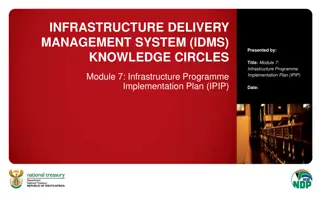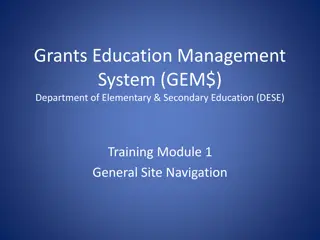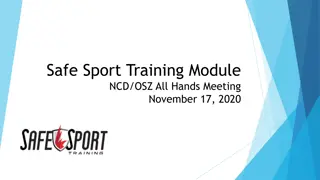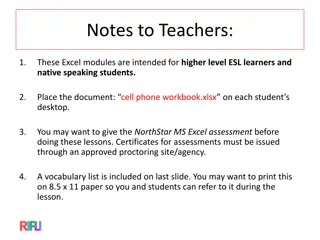
Airport Safety and Aircraft Incident Management
Enhance airport safety by understanding the elements of safeguarding frameworks and categorizing aircraft incidents for effective emergency response. Learn about the nature of aircraft accidents and how to mitigate risks within airport premises to ensure optimal security and resilience.
Download Presentation

Please find below an Image/Link to download the presentation.
The content on the website is provided AS IS for your information and personal use only. It may not be sold, licensed, or shared on other websites without obtaining consent from the author. If you encounter any issues during the download, it is possible that the publisher has removed the file from their server.
You are allowed to download the files provided on this website for personal or commercial use, subject to the condition that they are used lawfully. All files are the property of their respective owners.
The content on the website is provided AS IS for your information and personal use only. It may not be sold, licensed, or shared on other websites without obtaining consent from the author.
E N D
Presentation Transcript
Environmental issues and security
Safeguarding the Airport As the primary transport infrastructure assets in their respective regions, airports must be designed, managed, and operated with maximum protection against diverse and unforeseen hazard emergency circumstances. A well-planned and designed airport may be subjected to exogenous factors that engineers would never anticipate. Airport developers and engineers could prepare a certain situational awareness framework that could be useful in minimizing adverse effects on the airport of such unforeseen situations it would provide the first line of defense to safeguard the airport. So, what are the elements of this safeguarding framework? Three major parts to an airport safeguarding framework come to the forefront: safeguarding the airport airspace and airfield and enabling optimal safety awareness, securing the airport s public areas against unlawful interference, and responding to emergencies of all kinds.
Nature of Aircraft Accidents It is helpful for airport engineers to know where, when, and how aircraft accidents occur. Aircraft accident statistics indicate that only 5% of accidents occur en route. These are caused typically by structural fatigue, electromechanical failure, violent weather, hitting the ground (controlled flight into terrain, CFIT), or hitting obstructions close to the airport. Another 15% of accidents occur in the proximity (within 15 miles) of the airport arrival or departure areas. These accidents may be caused by weather, engine failure, or collision with another plane. These accidents are of primary concern to community emergency services around airports, and emergency response to these accidents are typically done with airports emergency services under a mutual aid agreements as discussed later for airport emergency plans.
Nature of Aircraft Accidents The remaining 80% of recent accidents occur within the airport active movement areas (i.e., runways, taxiways, and aircraft parking areas), an area 500 ft of the active runway centerline and 3000 ft of its threshold the critical rescue and fire-fighting response area. It is where human lives get lost or aircraft are damaged in accidents due to unnecessary obstructions and unfortunate crashes. It is here where airport design could be improved and can be more safety conscious and most effective. Measures related to removing any obstruction hazards from runway approach areas would prevent potential damage to aircraft in runway incursion incidents
Categorization of aircraft incidents Airport emergency managers categorize aircraft incidents on airports into: Undershoots. Constituting 40% of all incidents, where landing aircraft contact the ground or some elevated obstructions prior to the runway threshold. Due to the relatively high speed of the approach, the aircraft frequently continues its momentum and comes to rest near the runway, with severe structural damage usually occurring to the aircraft. Such accidents are typical of bad weather influence on the pilot s bad judgment of approach and touch-down area or wind shear and microburst. Runway Veer-Off. Constituting 35% of all incidents where the aircraft pilot loses directional control on either landing or takeoff caused by tire or break failure, skidding on a wet or icy runway during strong crosswind conditions. Runway Overrun. Constituting 25% of incidents and it occurs on landing caused by hydroplaning on an excessively wet runway, skidding on ice or snow, or excessive landing speed due to pilot error or misjudgment. A rejected takeoff would cause overruns caused by mechanical failure prior to liftoff, excessive aircraft weight, or a blown tire.
AIRPORT EMERGENCY PLANNING The major characteristics and components of a typical AEP include a definition of the scope and purpose, content and function, organization and development framework, training, and communication: 1. Definition. An airport emergency is an occurrence or instance, natural or manmade, which warrants action to protect and save lives, maintain public health, prevent or minimize property and infrastructure damage, and bring the airport back to normal operation and regular business. 2. Purpose. As prerequisite to airport certification, airports shall develop and maintain an AEP designed to minimize the possibility and extent of personal injury and property damage on the airport in an emergency. The AEP must be developed to facilitate the timely and appropriate response to emergencies occurring on or in the immediate vicinity of airports. The principal goal of the AEP is to prepare the organization to render adequate assistance and minimize further injury and damage to persons and property involved in the emergency situation.
3. Structure and Content. The AEP must include the procedures for prompt response to the emergencies, including: Aircraft incidents and accidents, including bomb incidents, where designated parking areas must be ready for aircraft involved Structural fires Natural disasters Medical and health disasters and radiological incidents Acts of terrorism, sabotage, hijack incidents, and other unlawful interference with operations Catastrophic failure of power Water rescue situations
4. Function and Organization. The AEP can provide the functional framework that: Assigns responsibility to organizations and individuals to carry out specific actions at projected times and places in responding to a specific emergency Sets forth lines of authority and organizational relationships and shows how all actions should be coordinated Describes how people and property will be protected in emergencies and disasters Identifies personnel, equipment, facilities, supplies, and other resources available within the airport or by agreement with other agencies or communities for use during response and recovery operations As a public document, cites its legal basis, states objectives, acknowledges assumptions, and sets communication links for coordination Facilitates response and short-term recovery to set the stage for successful long-term recovery
The functional elements of the AEP are structured into: Direction, command, and control Communication Alert and warning Emergency public information Protective actions Law enforcement Fire and rescue Health and medical Resource management Airport operations and maintenance
5. Plan Preparation. Development of the AEP includes: A rough draft of all elements to serve the planning team Committees to manage the AEP sections, through developing timelines, tasks, and schedules for follow-up meetings Liaising with airport stakeholders, agencies, and committee Preparing standardized graphics, charts, maps, etc., Producing the AEP document and circulating it to the stakeholder representatives on the planning team Prepare airport facilities plans and drawings based on the current and updated airport master plan and related engineering drawings. Obtaining concurrence from agencies, airport stakeholders, and associated organizations with identified responsibilities for AEP implementation Presenting the AEP document to the appropriate executives for promulgation Distributing the AEP to all parties with duties and responsibilities under the plan. Records are kept on AEP distribution, which should be limited and on need- to-know basis.
6. Verification of Conformity. The complete and endorsed AEP should always be checked for conformity to the applicable laws, regulation(s), and standards and to ensure that it functions as planned. Verification and validation of the AEP are done through consultation with the stakeholders emergency management officials regarding its review cycle. As part of this process, full-scale exercises are conducted to offer the best option to determine if an AEP actually works and is understood. 7. AEP Familiarization. On- and off-airport personnel familiarization with each other s equipment and facilities plans must be part of the plan. Off-airport personnel need to become familiar with the unique operating environment of an airport, and this is particularly critical during nighttime and low visibility. Manpower and staff assigned to support the AEP must get fully familiar with their roles and responsibilities and sufficiently tested through drills and exercises.
8. AEP Training Programs. The above is achieved through proper training. Personnels knowledge of the AEP, its facilities, equipment and vehicles, and the emergency response organizations (e.g., fire, medical, and police) knowledge of their responsibilities relative to the AEP, its facilities, equipment, and vehicles should follow rigorous training programs. For initial training, airport personnel should be primarily devoted to standard operating procedures (SOPs), and general training should be provided to all airport employees. Emergency response personnel should receive specialized training based on their individual job responsibilities. Furthermore, periodic training should be scheduled in order to prevent loss of knowledge and skills over time. Training should familiarize the personnel with: Standard operating procedures The airport layout plan (ALP) and facilities plans and engineering drawings of the current airport master plan. Communications, IT, and utilities systems and equipment, including cabling, circuit drawings, location of equipment, and routing of lines Emergency equipment Reporting systems
9. Training Methods and Equipment. As part of the AEP, an emergency training handbook with formal methods for training personnel should be prepared. Formal methods include, but are not limited to, classroom instruction, on-site familiarization, emergency training drills (for airport personnel, emergency response personnel, and the public), audiovisual (AV) training programs, and simulations (computer as well as live simulations). The handbook should also include such training methods as orientation seminars, drills, tabletop exercises, functional exercise, and full-scale exercises as well as the steps taken to develop them. These steps include needs assessment, and statement of purpose, identification of the goals and objectives, building scenarios, problem statements, and assessment of the success of the exercise. definition of the scope
10. Hazard Control during AEP Routine and Periodic Training. Because of the intense activity characteristic of most full-scale exercises, if not managed carefully, the exercise itself can cause accidents. Potential hazards during mounting AEP exercises at normal airport operation may occur and should be avoided. For operation-based exercises, since participants may be unfamiliar with aircraft operations, some could unintentionally interfere with the operation and accidents may result. The AEP should therefore include preventive actions and awareness measures. Other preventive measures of the AEP are related to potential injuries during exercise, victim training instructions, liability issues, public awareness and notification of the exercise through media, and undertaking corrective actions.
Environmental Impacts of Airports Airports are unique entities that have profound economic, social, and environmental effects on a local, regional, and even national level. They provide the means for the efficient movement of passengers and goods to virtually anywhere in the world, playing a vital role in the trend toward globalization and the interconnections between international trade and local economies. While the economic benefits of airports and air travel are commonly recognized, there is a social and environmental cost associated with constructing and operating airports.
Air Emissions / Quality The effects of airports and aircraft on air quality are complex and controversial effects not only occur in areas immediately surrounding airports but also occur on a regional and global level. Not only do emissions from airports and aircraft affect air quality in areas immediately surrounding airports, but aircraft exhaust is also emitted in the upper atmosphere during flight.
Emission sources at airports typically include the following: Aircraft emissions are a function of the number of annual aircraft operations, the aircraft fleet mix (types of aircraft and engines serving an airport), and the length of time aircraft spend in various modes of the landing and takeoff cycle. Six aircraft operating modes comprise a landing and takeoff (LTO) cycle: approach to the airport, landing roll on the runway, taxi in from the runway to the gate or apron, taxi out from the gate or apron to the runway, takeoff on the runway, and climbout from the airport. An auxiliary power unit (APU) is a small turbine engine that generates electricity and compressed air to operate aircraft instruments, lights, and ventilation when aircraft are parked at the gate, and the APU can also be used to provide power to start the main aircraft engines. Because jet fuel is used as the power source for APUs, they emit exhaust.
Ground support equipment such as tugs that haul baggage carts, fuel trucks, and catering trucks also create exhaust. Additionally, passengers, employees, hotel and rental car shuttles, parking shuttles, and suppliers all generate motor vehicle traffic on airport roadways and in parking lots that can be a significant source of pollutant emissions at an airport. Construction emission sources can include construction vehicles and equipment, land development activities, asphalt paving activities, asphalt batch plants, and painting activities. Stationary sources can include heating and cooling plants, emergency generators, and other industrial facilities located on airport property. An assessment of air quality effects at an airport needs to consider all of these factors. The vast number and types of activities that can affect air quality make understanding and properly characterizing these effects a complex and challenging process.






















